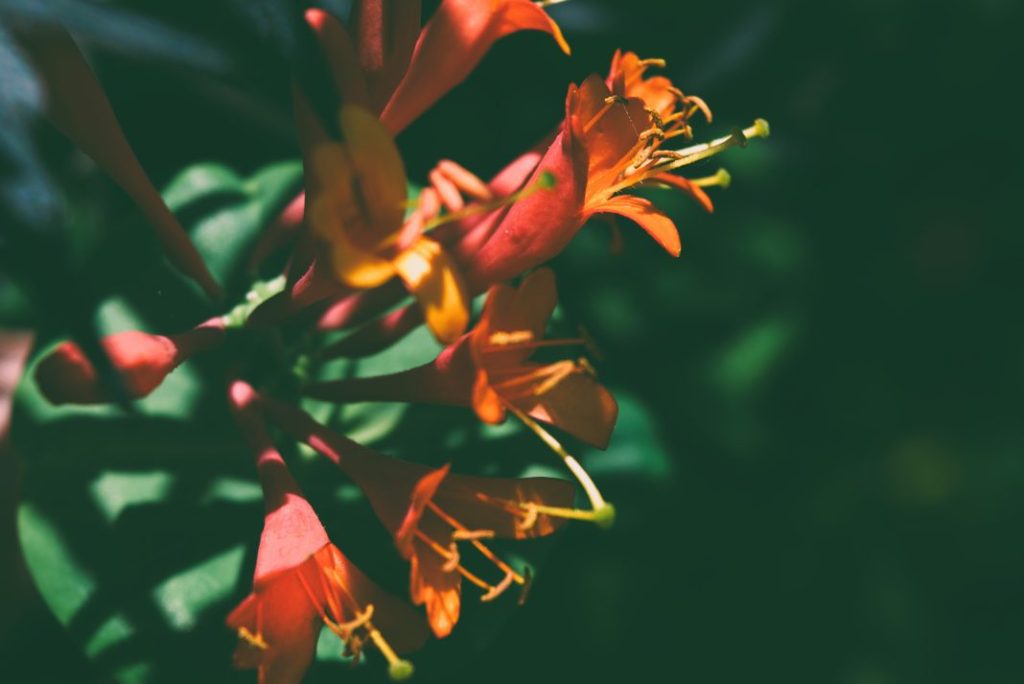Lonicera ‘Dropmore Scarlet’, commonly known as the Dropmore Scarlet Honeysuckle, is a beautiful and versatile climber that brings a splash of vibrant color to gardens. This honeysuckle variety, with its striking scarlet flowers, is not only visually appealing but also a magnet for pollinators like hummingbirds and butterflies. This article explores the history, relevance to UK tropical gardens, and offers detailed care tips for growing Lonicera ‘Dropmore Scarlet’.
History of Lonicera ‘Dropmore Scarlet’
Lonicera ‘Dropmore Scarlet’ is a hybrid honeysuckle, created by renowned plant breeder Frank Skinner in Dropmore, Manitoba, Canada, in 1950. Skinner aimed to develop a hardy honeysuckle that could withstand the cold Canadian climate while still producing vibrant blooms. By crossing Lonicera sempervirens with other species, he succeeded in creating ‘Dropmore Scarlet’, a cultivar celebrated for its hardiness and beauty. Since its introduction, this honeysuckle has gained popularity worldwide, including in the UK, for its resilience and ornamental value.
Relevance to UK Tropical Gardens
While Lonicera ‘Dropmore Scarlet’ is not a tropical plant, its vivid flowers and lush foliage make it a valuable addition to UK tropical gardens. Its ability to thrive in temperate climates allows it to complement the exotic aesthetic often sought in tropical-themed landscapes. The plant’s vigorous growth and climbing habit provide vertical interest, making it ideal for covering trellises, fences, and pergolas. Its tubular scarlet flowers, which bloom from late spring to early autumn, add a burst of color that enhances the tropical garden ambiance.

Care Tips for Growing Lonicera ‘Dropmore Scarlet’
Light Requirements: Lonicera ‘Dropmore Scarlet’ thrives in full sun to partial shade. While it prefers full sun for optimal flowering, it can tolerate some shade, especially in hotter climates.
Soil: This honeysuckle is adaptable to various soil types but prefers well-drained, fertile soil. Adding organic matter like compost can improve soil fertility and drainage, promoting healthier growth.
Watering: Regular watering is essential, particularly during the plant’s establishment period and dry spells. While it is relatively drought-tolerant once established, consistent moisture helps produce more abundant blooms.
Fertilizing: Feed the plant with a balanced, slow-release fertilizer in early spring to support vigorous growth and flowering. Avoid excessive nitrogen, which can lead to more foliage at the expense of flowers.
Pruning: Pruning is crucial for maintaining the shape and health of Lonicera ‘Dropmore Scarlet’. Prune in late winter or early spring, removing dead or weak stems and cutting back any overgrown areas to encourage new growth. Light pruning after the first flush of flowers can also promote additional blooming.
Support Structures: Provide sturdy support structures like trellises, fences, or pergolas for the plant to climb. Train the vines by gently tying them to the support as they grow, ensuring even coverage and better airflow.
Pest and Disease Management: Lonicera ‘Dropmore Scarlet’ is generally pest-resistant but can occasionally attract aphids and powdery mildew. Regular inspection and appropriate treatments, such as insecticidal soap for aphids and fungicides for mildew, can help manage these issues.
Propagation: Propagate Lonicera ‘Dropmore Scarlet’ through softwood cuttings in late spring or early summer. Take cuttings from healthy, non-flowering shoots, and root them in a mixture of sand and peat under high humidity conditions.
Conclusion
Lonicera ‘Dropmore Scarlet’ is a robust and stunning climber that offers both beauty and versatility to gardens. Its history as a hardy hybrid and its vibrant scarlet blooms make it a standout choice for UK tropical gardens. With proper care, including adequate sunlight, well-drained soil, regular watering, and annual pruning, this honeysuckle can thrive and bring a tropical flair to any garden space. Whether used to cover a trellis or add vertical interest to a garden border, Lonicera ‘Dropmore Scarlet’ is sure to captivate with its enduring charm and vibrant display.
